Cover art
Cover art is a type of artwork presented as an illustration or photograph on the outside of a published product such as a book (often on a dust jacket), magazine, newspaper (tabloid), comic book, video game (box art), DVD, CD, videotape, music album (album art) or podcast.[1] The art has a primarily commercial function, for instance to promote the product it is displayed on, but can also have an aesthetic function, and may be artistically connected to the product, such as with art by the creator of the product.[2][3]

Album cover art
Album cover art is artwork created for a music album. Notable album cover art includes Pink Floyd's The Dark Side of the Moon, King Crimson's In the Court of the Crimson King, the Beatles' Sgt. Pepper's Lonely Hearts Club Band, Abbey Road and their self-titled "White Album" among others. Albums can have cover art created by the musician, as with Joni Mitchell's Clouds,[4] or by an associated musician, such as Bob Dylan's artwork for the cover of Music From Big Pink, by the Band, Dylan's backup band's first album. Artists known for their album cover art include Alex Steinweiss, an early pioneer in album cover art, Roger Dean, and the Hipgnosis studio. Some album art may cause controversy because of nudity, offending churches, trademark or others.[5] There have been numerous books documenting album cover art, particularly rock and jazz album covers.[6][7][8] Steinweiss was an art director and graphic designer who brought custom artwork to record album covers and invented the first packaging for long-playing records.[5]
Book cover
Whether printed on the dust jacket of a hardcover book, or on the cover of a paperback, book cover art has had books written on the subject.[9] Numerous artists have become noted for their book cover art, including Richard M. Powers and Chip Kidd. In one of the most recognizable book covers in American literature, two sad female eyes (and bright red lips) adrift in the deep blue of a night sky, hover ominously above a skyline that glows like a carnival. Evocative of sorrow and excess, the haunting image has become so inextricably linked to The Great Gatsby that it still adorns the cover of F. Scott Fitzgerald’s masterpiece 88 years after its debut. The iconic cover art was created by Spanish artist Francis Cugat. With the release of a big Hollywood movie, however, some printings of the book have abandoned the classic cover in favor of one that ties in more closely with the film. [10] [11]
A book cover is usually made up of images (illustrations, photographs, or a combination of both) and text. It usually includes the book title and author and can also include (but not always) a book tagline or quote. The book cover design is usually designed by a graphic designer or book designer, working in-house at a publisher or freelance. Once the front cover art has been approved, they will then continue to design the layout of the spine (including the book title, author name and publisher imprint logo) and the back cover (usually including a book blurb and sometimes the barcode and publisher logo). Books can be designed as a set of series or as an individual design. Very commonly the same book will be designed with a different cover in different countries to suit the specific audience. For example, a cover designed for Australia may have a completely different design in the UK and again in the USA.
Magazine cover
Magazine cover artists include Art Spiegelman, who modernized the look of The New Yorker magazine, and his predecessor Rea Irvin, who created the Eustace Tilly iconic character for the magazine.
Tabloid cover
Today the word tabloid is used as a somewhat derogatory descriptor of a style of journalism, rather than its original intent as an indicator of half-broadsheet size. This tends to cloud the fact that the great tabloids were skilfully produced amalgams of intriguing human interest stories told with punchy brevity, a clarity drawn from the choice of simple but effective words and often with a healthy dose of wit.[12] The gossipy tabloid scandal sheets, as we know them today, have been around since 1830. That's when Benjamin Day and James Gordon Bennett Sr., the respective publishers of The New York Sun and The New York Herald, launched what became known as the Penny Press (whose papers sold for one cent apiece).[13] But some of the world's best journalism has been tabloid.[14] From the days when John Pilger revealed the cold truth of Cambodia's Killing Fields in the Daily Mirror, to the stream of revelations that showed the hypocrisy of John Major's "back to basics" cabinet, award-winning writing in the tabloids is acknowledged every year at the National Press Awards.[14] Good cover art can lead readers to this fact; the New York Herald, for example, offers some fine examples of tabloid cover art.[15] [16] So too does the News & Review, a free weekly published in Reno, Nevada, Chico, California and Sacramento, California. [17] The tabloid has thrived since the 1970s, and even uses cartoonish cover art. [18] Tabloids have a modern role to play, and along with good cover art (and new ideas) they fill a niche.[19]
Popular music scores (early 20th century)
Sheet music cover artists include Frederick S. Manning, William Austin Starmer, Frederick Waite Starmer, all three of whom worked for Jerome H. Remick. Other prolific artists included Albert Wilfred Barbelle, Andréa Stephen Chevalier de Takacs (1880–1919),[20] and Gene Buck. E. H. Pfeiffer (né Edward Henry Pfeiffer; 1868–1932)[21] did cover illustrations for Gotham-Attucks, Jerome H. Remick, F.B. Haviland Pub. Co., Jerome & Schwartz Publishing Company, Lew Berk Music Company, Waterson, Berlin & Snyder, Inc., and others.
Gallery
Books
 Ivory book cover with scenes from the life of Christ circa 800 AD
Ivory book cover with scenes from the life of Christ circa 800 AD.png.webp) Kipling's A song of the English (poem), illustrated by William Heath Robinson (1872–1944), 1909
Kipling's A song of the English (poem), illustrated by William Heath Robinson (1872–1944), 1909 Uezdnoe, by Yevgeny Zamyatin, 1916
Uezdnoe, by Yevgeny Zamyatin, 1916 The Real Mother Goose, Blanche Fisher Wright, illustrator, 1916
The Real Mother Goose, Blanche Fisher Wright, illustrator, 1916
Newspapers, magazines, comic books
 Gentleman Jim Corbett and John L. Sullivan at the Olympic Club, New Orleans, The Times-Democrat, September 8, 1892
Gentleman Jim Corbett and John L. Sullivan at the Olympic Club, New Orleans, The Times-Democrat, September 8, 1892 Billboard's tenth anniversary edition, 1904
Billboard's tenth anniversary edition, 1904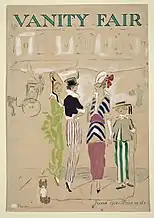 Vanity Fair, June 1914
Vanity Fair, June 1914 Skater with scarf, illustrated by Ethel Caroline Rundquist, Vanity Fair, January 1916
Skater with scarf, illustrated by Ethel Caroline Rundquist, Vanity Fair, January 1916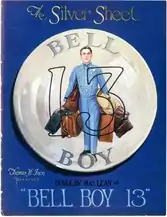 The Silver Sheet, a studio publication promoting Thomas Ince Productions Bell Boy 13, E. H. Pfeiffer, illustrator, January 1923
The Silver Sheet, a studio publication promoting Thomas Ince Productions Bell Boy 13, E. H. Pfeiffer, illustrator, January 1923 Pulp magazine Spider, Vol. 2, No. 3, April 1934
Pulp magazine Spider, Vol. 2, No. 3, April 1934 Amazing Man Comics, illustrated by Paul Gustavson, 22, May 1941
Amazing Man Comics, illustrated by Paul Gustavson, 22, May 1941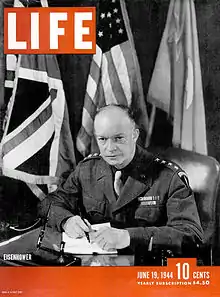 LIFE magazine, official U.S. Army photo, June 19, 1944
LIFE magazine, official U.S. Army photo, June 19, 1944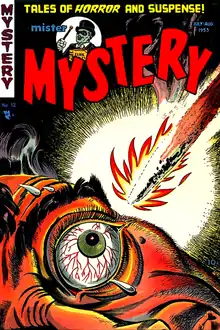 Mister Mystery #1, Key Publications, July-August 1953
Mister Mystery #1, Key Publications, July-August 1953 The first Horisont magazine in Estonia, 1967
The first Horisont magazine in Estonia, 1967
Sheet music, recorded music
 Sheet music for the Broadway musical, Bandanna Land, Andréa Stephen Chevalier de Takacs, illustrator, Gotham-Attucks, publisher, 1908
Sheet music for the Broadway musical, Bandanna Land, Andréa Stephen Chevalier de Takacs, illustrator, Gotham-Attucks, publisher, 1908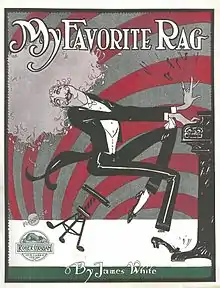 "My Favorite Rag," by James White, illustration by Grim Natwick (one of his earliest published works), 1915
"My Favorite Rag," by James White, illustration by Grim Natwick (one of his earliest published works), 1915 Album cover for The Beatles, aka White Album, 1968
Album cover for The Beatles, aka White Album, 1968
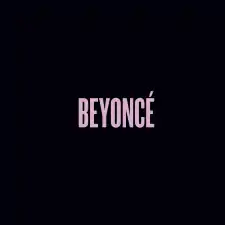
See also
| Wikimedia Commons has media related to Cover art. |
References
- https://podcastart.co/
- "Examples @ Pinterest". Archived from the original on 2020-02-17. Retrieved 2017-08-28.
- "Jacek Utko".
- "Clouds". JoniMitchell.com. Les Irvin. Retrieved 8 June 2014.
- Heller, Steven, "Alex Steinweiss, Originator of Artistic Album Covers, Dies at 94," New York Times, July 19, 2011
- "The Blues: Album Cover Art", Chronicle Books, 1996
- 1000 Record Covers, Michael Ochs, Taschen Publications, 2005
- Borgerson, Janet (2017). Designed for hi-fi living : the vinyl LP in midcentury America. Schroeder, Jonathan E., 1962-. Cambridge, Massachusetts: MIT Press. ISBN 9780262036238. OCLC 958205262.
- "Sample Book List".
- "Smithsonian Magazine".
- 2013 film
- Day, Mark. (2008, August 21). “For a brighter future, tabloids could look to the past.” The Australian, p. 38.
- McLaren, Leah. (2001, August 11). “Admit it: Tabloid culture is what we are” The Globe and Mail, p. L3.
- Wynne-Jones, Ros. (2011, July 28). “They've still got news for us.” Independent Extra, p. 2.
- "Siouxland Observer".
- "Herald Cover Art".
- "News & Review".
- "Chico Archive".
- Berlin, Jess S. (2006, November 8). “Cyber tabloid will cover all the news that's virtually true.” The Guardian, p. 20.
- "André De Takacs" by Bill Edwards (né William G. Motley; born 1959), ragpiano
.com Website administrator: Bill Edwards (no date); Contributors: Andrea Ellis and Keith Emmons (retrieved February 21, 2020) - "Edward H. Pfeiffer" by Bill Edwards (né William G. Motley; born 1959), ragpiano
.com Website administrator: Bill Edwards (no date)